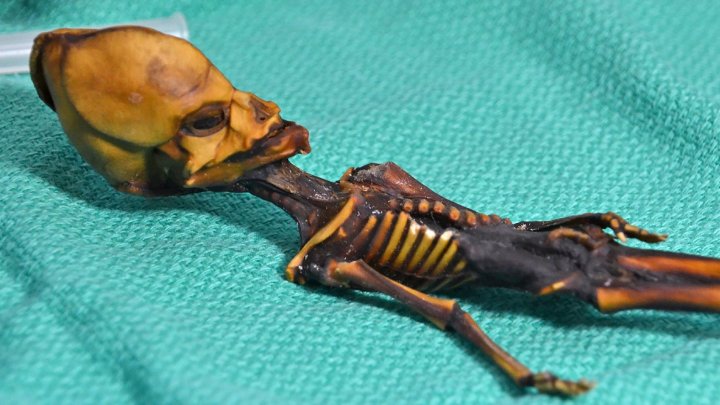DNA tests proved that skeleton named Ata, considered to be alien, is a human
 foto: nytimes.com
foto: nytimes.com
Scientists have revealed the origins of a mysterious skeleton long thought to have been extra-terrestrial.
After five years of examination, a research team unravelled the genetic make-up of the bizarre specimen found in the Atacama Desert in 2003, and nicknamed “Ata”.
Led by researchers at the University of California, San Francisco and Stanford University, forensic analysis of the remains revealed they undoubtedly belonged to a human, albeit one with severe and previously unknown genetic mutations.
The skeleton, which was discovered in a leather pouch behind an abandoned church and has been dated approximately to the 1970s, has been the subject of intense speculation among online alien enthusiasts ever since it was revealed to the world.
Standing at 15 centimeters tall, the skeleton has an elongated skull, slanted eye sockets and only 10 pairs of ribs instead of the usual 12.
Despite its tiny stature, the bone development of the skeleton matches that of a six-year-old child.
Since its initial discovery, Ata was sold on to the black market and eventually passed into the hands of a Spanish businessman.
Dr Garry Nolan, a microbiologist at Stanford University, first heard of the specimen through a friend, and resolved to get to the bottom of its mysterious origins.
"You can't look at this specimen and not think it's interesting; it's quite dramatic,” said Dr Nolan.
“So I told my friend, 'Look, whatever it is, if it's got DNA, I can do the analysis."
After contacting the makers of Sirius, Dr Nolan and his colleagues were given the opportunity to undertake just such an analysis.
Having examined the remains, they concluded the skeleton undoubtedly belonged to a female human foetus with a mix of Native American and European ancestry, although the reason for her unusual appearance remained unknown.
For the next stage of the investigation, Dr Atul Butte joined the team to help understand exactly what genetic factors resulted in the specimen’s appearance.
Earlier analysis had demonstrated that the Ata skeleton had plenty of high-quality DNA for modern sequencing technology to unravel.
Using cutting-edge techniques, the scientists found rare mutations linked to dwarfism and a variety of other bone and growth disorders.
The investigation also revealed four genetic mutations presumed to be involved with bone diseases, all of which were previously unknown to science.
These mutations are the cause of both Ata’s unusual appearance and the premature ageing of her bones, which made her appear much older than she really was.
"When doctors perform analyses for patients and their families, we're often searching for one cause – one super-rare or unusual mutation that can explain the child's ailment. But in this case, we're pretty confident that multiple things went wrong," said Dr Butte.
The results of this analysis were published in the journal Genome Research.
Besides solving a 15 year-old mystery, the scientists say the success of their project could be useful for modern medicine as well, and points to ways in which complex living cases can be handled.
Read more on: Independent.